Abstract
This study investigates the potential of two bitumen modifiers, high-density polyethylene (HDPE) and nano clay (NC), to enhance the rutting resistance of asphalt mixture. Four HDPE asphalt binders were prepared by mixing the HDPE at percentages of 2%, 4%, 6%, and 8% with the virgin binder, while four NC asphalt binders were produced by mixing the NC at percentages of 1%, 2%, 3%, and 4%. The consistency and flow of virgin binder, HDPE binders, and NC binders were evaluated by penetration, softening point, and viscosity tests. The results show a gradual increment in the binder stiffness by increasing the percentage of both modifiers. The static creep test was conducted at a temperature of 40 °C to evaluate the rutting resistance. The results confirm that both modifiers can greatly improve the rutting resistance of the asphalt mixture, where 8% HDPE and 3% NC modifications reduce the strains provoked in the asphalt mixture under loading by about 50%. According to the correlation analysis, the mixture rutting performance is highly attributed to the binder stiffness, where the lower the penetration value of the asphalt binder, the lower the strains in the asphalt mixture and the higher the stiffness modulus of the asphalt mixture.
1. Introduction
1.1. Background
Rutting generally happens prior to the pavement’s service life [1,2,3,4]. In order to enhance the performance of binder and mixes of asphalt-concrete, in recent years, it has become more and more common to incorporate modifiers such as polymers and nano additives [5,6,7]. Polymers make asphalt mixture stiffer in hot conditions, which reduces strain caused by the influence of traffic loads [8,9]. One of the polymer kinds that exhibits endurance, hardness, and tolerance to hot conditions is high-density polyethylene [10,11]. Hınıslıoğlu and Ağar (2004) [12] investigated the effects of 4–8% high-density polyethylene addition rates on asphalt. The outcomes revealed a rise in deformation resistance and an improvement in Marshall stability [13]. In order to create the polymer-modified binder, Habib et al. (2011) [14] utilized a mixer for 60 min at 170 °C and 120 rpm. By weight of the binder, they added polyethylene at rates ranging from 0.5% to 5%. The findings show that high-density polyethylene reduced permanent deformation and increased the mixture’s hardness. Ahmed and AL-Harbi (2014) [15] incorporated high-density polyethylene utilizing the wet process for 90 min at a temp of 185 °C with concentration levels of (2, 5, and 7%) by weight of asphalt mixture (40/50). According to findings, high-density polyethylene enhanced both the rutting depth and the Marshall stability of the mix. The effect of HDPE on asphalt was assessed by Moghadas Nejad et al. (2015) [16], and colleagues investigated the effect of HDPE on asphalt mixture at high temps. They claimed that the rutting factors had significantly improved [16].
Numerous applications have made use of nanoparticles to enhance the qualities of various materials [17,18,19]. Numerous studies compared the rheological characteristics of bitumen that had been changed with nano clay to bitumen that had not been nano-modified [20,21,22,23]. The outcomes showed that adding nano clay to bitumen increased the samples’ resistance to rutting significantly. Sajedi and Razak (2011) [21] investigated and analyzed the performance of hot asphalt mixture and nano-silica-modified bitumen in this regard [21], and the findings demonstrated advancements in rutting depth and creep tolerance. According to You et al., 2011 [24], 2% of nano clay in the binder may result in a rise of up to 184% in the shear (complex) modulus [24]. This suggests that the asphalt’s ability to withstand rutting has probably been enhanced. The impact of introducing Nano-TiO2 on the behavior of stone mastic asphalt-concrete mixes was examined by Sadeghnejad and Shafabakhsh (2017) [25]. The study’s primary findings demonstrated that Nano-TiO2 was more successful at enhancing fatigue and rutting metrics [25].
Even while various studies have evaluated employing high-density polyethylene and nano clay as a binder modifier, only a few of them have looked at its impact on the asphalt blend’s propensity to rut utilizing static creep tests, particularly in the case of adding high-density polyethylene to bitumen utilizing the wet blending technique. In order to determine how adding high-density polyethylene and nano clay as a binder ingredient impacts the susceptibility of the modified asphalt mix to rut, this study’s main objective is to ascertain this relationship. Using the static creep test, a simple and inexpensive experimental technique, rusting propensity was investigated. The quality of high-density polyethylene and nano clay’s dispersion in the asphalt mixture was observed after wet mixing utilizing the SEM.
1.2. Novelty
Even though several previous studies have examined the use of high-density polyethylene (HDPE) and nano clay as a modifier for binders, only a limited number of them have explored the effects on the asphalt blend’s susceptibility to rutting using static creep tests, particularly when incorporating HDPE into bitumen through the wet blending technique. The main objective of this study is to influence how the addition of HDPE and nano clay as binder modifiers influences the rutting behavior of the modified asphalt mixture. The investigation of rutting propensity was carried out using the static creep test, which is a simple and cost-effective experimental technique. Additionally, the dispersion quality of HDPE and nano clay in the asphalt mixture was observed by employing scanning electron microscopy (SEM) after wet mixing.
1.3. Objective and Research Approach
The following research objectives have been identified:
- First, study the rheological properties of HDPE-, NC-modified binders;
- Next, based on static creep testing, evaluate the susceptibility of the HDPE-, NC-modified asphalt mixtures to rutting that is essential for designing and constructing durable and long-lasting asphalt pavements;
- Finally, analyze the relationship between creep parameters and basic properties of modified binders using correlation analysis.
Figure 1 presents an overview of the research methodology employed in this study.

Figure 1.
Experimental and analytical work outline.
2. Material Properties and Sample Preparations
2.1. Material Properties
The asphalt binder of 60/70 penetration grade, which is commonly utilized in Egypt, was used in this study. The binder’s basic characteristics are listed in Table 1. The high-density polyethylene and nano clay have been used as binder modifiers. Figure 2a shows the particles shape of the high-density polyethylene, while Table 2 presents its main mechanical and physical properties. The surface morphology and mineral composition of the nano clay, shown in Figure 2b, were tested using scanning electron microscopy (SEM) and X-ray diffraction (XRD), respectively. The asphalt binder and modifiers were provided by local companies in Sohag City in Egypt. The petrol industry of Egypt is the source of the asphalt binders used in the country.

Table 1.
Basic properties of the virgin binder.
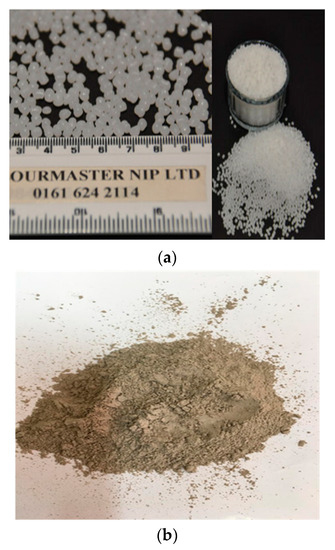
Figure 2.
Appearance of the asphalt modifiers. (a) High-density polyethylene; (b) Nano clay powder.

Table 2.
Mechanical and physical characteristics of high-density polyethylene.
The SEM utilizes Cu-K radiation with a 2-scan range of 5.005–8.99757° to capture the particle size and surface morphology. As shown in Figure 3, the SEM scanning for nano clay reveals that the particles diameter generally varies from 15 to 40 nm. The XRD test exposes the tested material to X-rays, which are diffracted by hitting the composing crystals. Each mineral component has its unique crystal composition. Thus, the diffraction angle of X-rays can reveal the mineral composition of the material. The XRD pattern of the nano clay, shown in Figure 4, shows multiple peaks corresponding to different diffraction angles, where the highest peak is ascribed to the Al2Si2O5(OH)4. Table 3 also presents the other physical properties of nano clay.
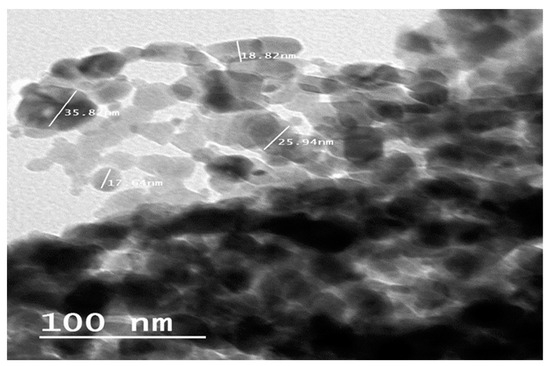
Figure 3.
Nano clay under SEM.
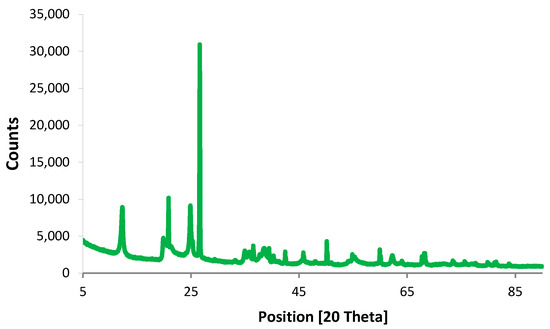
Figure 4.
XRD pattern of nano clay powders.

Table 3.
Chemical characteristics of nano clay.
2.2. Binder and Mixture Preparations
Both the high-density polyethylene and nano clay were mixed with the asphalt binder for 60 min utilizing a shear blender of 4000 rpm to produce polyethylene-modified binder (HDPE) and nano clay-modified binder (NC). Based on the recommendations of previous studies [25,38,39], the mixing temperatures were selected to be 180 °C and 145 °C for the production of HDPE and NC, respectively.
The aggregates used for the asphalt mixture were a coarse aggregate of crushed dolomite, a fine aggregate of siliceous sand, and a mineral filler of limestone dust. The aggregates were sourced from the local contractors of Sohag City in Egypt, where the mountains and desert surrounding the city are the main source for the aggregate used in the construction in the city. The three aggregate types were mixed together to form a combined aggregate which fulfils the gradation of dense graded wearing course (4C) specified in the Egyptian standard specifications [40]. Figure 5 shows the gradation of the combined aggregate as well as the lower and upper limits according to the Egyptian specifications for the aggregate gradation of the surface asphalt layer. The basic properties of the aggregate are shown in Table 4. The optimum bitumen content (OBC) was estimated according to the Marshall-Mix-design approach [41]. The bitumen content, which achieves an air void ratio of 4%, was found to be 5%. As shown in Table 5, the volumetric characteristics and load stability of the asphalt mixture at this bitumen content fulfil the specifications. Therefore, the OBC was decided to be 5% for all kinds of asphalt binders.
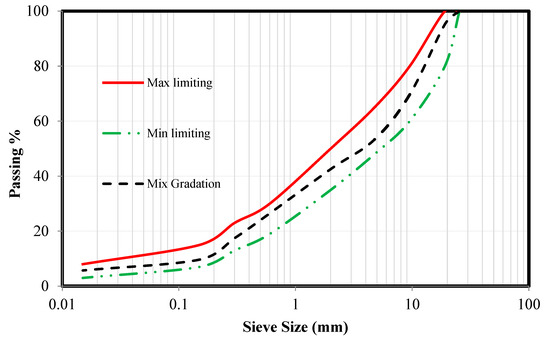
Figure 5.
Aggregate gradation.

Table 4.
Basic properties of the aggregate.

Table 5.
Marshall-design criteria for the normal asphalt mixture.
3. Experimental Work
3.1. Binder Consistency and Flow
The binder’s consistency, hardness, and flow were evaluated by conducting the softening point test (ASTM D 36 [31]), penetration test (ASTM D 5/D 5M [26]), and rotational viscosity (RVs) test (ASTM D 2170 [27]). As shown in Equation (1), the penetration-index (PI) was determined, based on the softening point and penetration depth, to assess the temperature sensitivity of the asphalt binders [47]. High PI reflects a low temperature sensitivity for the asphalt binder. Generally, a PI value between −2 and +2 is suggested for the construction of road pavements [48,49]. The binder viscosity at a temperature of 135 °C was also measured using the RVs.
where TR&B and P25 are the respective penetration depth value at 25 °C (expressed in increments of 0.1 mm) and softening point temp (measured in °C).
3.2. Rutting Characteristics of Asphalt Mixture
The rutting characteristics of asphalt mixtures of virgin, HDPE, and NC binders were evaluated by conducting the static creep test using the universal-testing machine (UTM). In this test, a cylindrical specimen of asphalt mixture is fabricated and tested under a controlled temperature. As shown in Figure 6a, the test specimen is put between a fixed plate and a moving plate connected with a loading piston [50,51,52]. The test specimen is loaded uniaxially for one hour and unloaded for 30 min. The vertical deformation with time is recorded using LVDTs. As elaborated in Figure 6b, during the loading period, the specimen accumulated strain increases gradually with time after initial deformation within the first few seconds. During the unloading period, the specimen partially rebounds and part of the acquired accumulated deformation during the loading period is recovered. However, part of the accumulated deformation remains as a permanent deformation in the specimen at the end of the unloading period. Accordingly, it is possible to record both the plastic (irrecoverable) and elastic (recoverable) deformations [53,54]. For each asphalt mixture, three repeated samples were conducted to ensure repeatability. The specimen dimensions and the test conditions adopted in this test can be encapsulated in the following points:
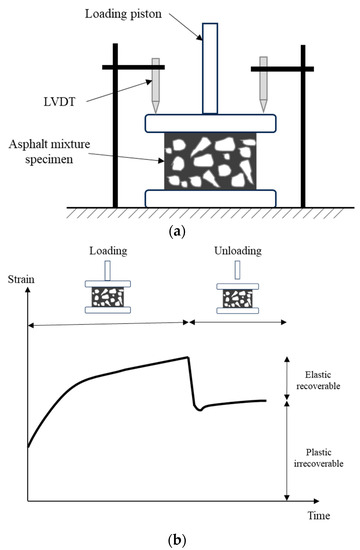
Figure 6.
Static creep test for asphalt mixture. (a) Sample loading; (b) Strain provoked in the sample during the loading and unloading stages.
- Testing temperature: 40 °C;
- Vertical stress: 0.1 MPa;
- Loading time: 3600 s;
- Unloading time: 1800 s;
- Specimen dimensions: 64 mm height and 102 mm diameter;
- Curing: Specimens were placed at 40 °C for four hours before testing.
As important predictors of an asphalt-concrete mix’s susceptibility to rutting, creep stiffness modulus, four creep aspects-accumulated-axial-strain, creep compliance factors, and creep compliance were identified [55,56]. As stated in Equation (2), the accumulated axial strain (Ɛ(t)) is defined as the ratio of the sample deformation (Δh) to its original height (ho) at any given time (t). In addition, as stated in Equation (3), the creep stiffness modulus (Smax) is defined as the ratio of the applied stress (σ) to the maximum axial strain (Ɛmax). The ability of the asphalt mixture to endure the applied load without deforming is estimated by the creep stiffness modulus (Smax) value. The higher the stiffness modulus, the higher the resistance to the deformation under loading.
The creep compliance of the asphalt-concrete mixture, on the other side, is a fundamental property of a viscoelastic material that explains the relationship between time-dependent strain and applied stress under an applied axial load. The creep compliance J(t) is determined by dividing the strain (Ɛ(t)) by the applied stress (σ) at any time (t) during loading, as given in Equation (4).
Furthermore, the creep compliance factors (a and m) are regarded as the material’s regression coefficients, indicating the linear portion of the material’s log creep compliance-log time curve during the loading period, where the intercept and slope of the curve are denoted by the letters a and m, respectively. A power model is typically utilized to estimate the creep compliance factors, as shown in Equation (5) [57,58].
where a and m are creep compliance factors, Jo is the instantaneous creep compliance, which is the creep compliance at the start of the static creep test (typically at the time of 0.1 s), J′ is the viscoelastic component of the creep compliance at any loading time (t), J(t) is creep compliance at any loading time (t), etc.
3.3. Correlation Analysis
Regression modeling was adopted to investigate the correlations between different parameters and develop simple prediction models for the strains provoked in the asphalt mixture under axial loading. The developed models target to provide an explanation for the creep behavior of the asphalt mixtures. Besides the correlation coefficient (R2), two statistical tests, a t-test and an f-test, were deemed to check the model’s significance. The t-test checks the significance of each proposed predictor by pursuing the difference between the null hypothesis (case of no modeling) and the alternative hypothesis (regression modeling). The probability (p value) that the two hypotheses are similar was determined to judge the relative role of a predictor in explaining the data variation. The f-test checks the change in the data variance by modeling. The probability (p value) that the data variance before and after modeling is similar was determined. The predictor was considered with no significant impact and the entire model was rejected in case of a p value larger than 0.05.
4. Results
4.1. Binder Evaluation Results
Figure 7, Figure 8 and Figure 9 elaborate on the penetration, softening point, penetration index, and viscosity of the virgin and modified asphalt binders. The results reveal a great impact for both modifiers on the binder consistency and flow. Generally, the modified binders have lower penetration, higher softening point, lower penetration index, and higher viscosity than the base binder. Accordingly, it can be concluded that the HDPE and NC significantly escalate the binder stiffness. However, by increasing the modifier dosage, it is possible to further reduce the penetration depth and increase the RVs and PI values. This shows an improvement in the heat stiffness and sensitivity of the binder, leading to stronger resistance to permanent deformation at higher temperatures. However, under extreme dosages of 6% and 8% high-density polyethylene, the viscosity increases to 4991 MPa and 9647 mPa.s, respectively, and does not meet the workability criterion for the asphalt mixture (3000 mPa.s). Moreover, the results also show that the HDPE asphalt binders have lower penetration and a higher softening point than NC binders.
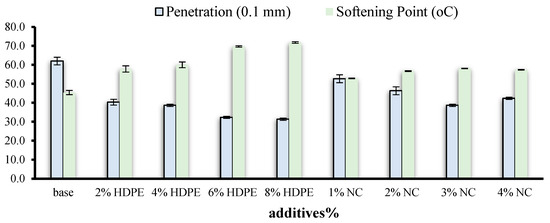
Figure 7.
Penetration depth and softening point of base and modified binders.
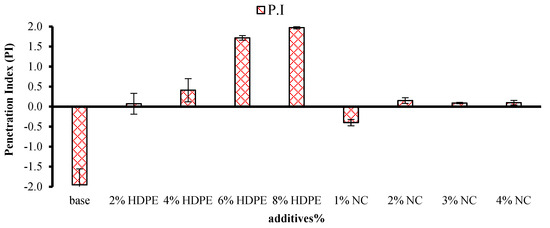
Figure 8.
Penetration-index of base and modified binders.
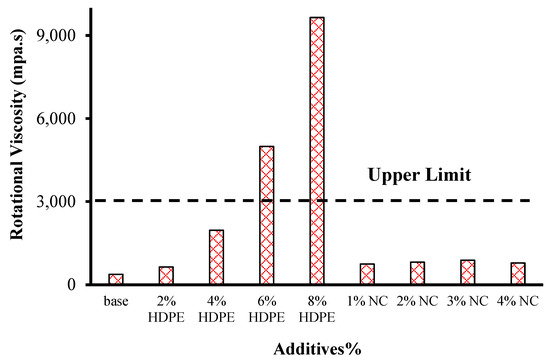
Figure 9.
RVs of base and modified binders.
4.2. Creep Resistance of Asphalt Mixture
During the loading and unloading phases of the static creep test, the vertical deformations of the asphalt specimen were observed. Three replicates (specimens) of each mix were averaged out to determine the findings. The rutting propensity of normal and modified asphalt mixtures was then assessed by taking into consideration four creep aspects: creep stiffness modulus, accumulated axial strain, creep compliance, and creep compliance factors.
The cumulative axial strains over time, both during loading and unloading, were calculated, and are displayed in Figure 10 and Figure 11. By comparison with the strain accumulated in the asphalt mixture of the virgin binder, it is clear that adding either high-density polyethylene or nano clay particles greatly attenuates the mixture strain under loading, assuring their high potential to enhance the mixture resistance to deformation and rutting. Generally, the maximum strain of the asphalt mixture of the virgin binder is almost two times of the 8% HDPE and 3% NC asphalt mixtures. However, the potential of HDPE to reduce the mixture deformation is higher than that of NC. The addition of 2% HDPE significantly reduces the mixture strain during loading, whereas the deformation reduction due to 2% NC is slight. Although the asphalt mixture of the virgin binder has the highest reduction in the accumulated strain due to unloading, the asphalt mixtures of modified binders with high modifier dosage have significantly lower permanent deformation.
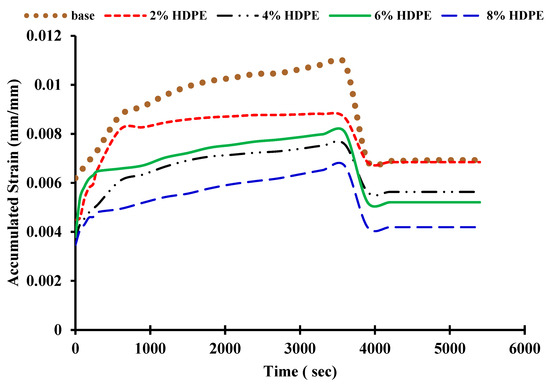
Figure 10.
The accumulated axial strain with time for high-density polyethylene-modified mixtures.
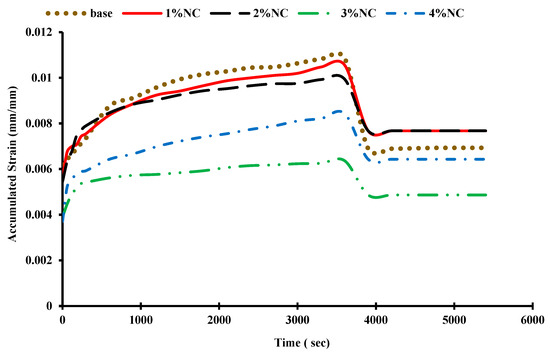
Figure 11.
The accumulated axial strain with time for nano clay-modified mixtures.
Table 6 shows different criteria of asphalt mixture deformation, including maximum stain (Ɛmax), which is the strain at the end of the loading period; elastic strain (Ɛelas), which is the clear difference between the permanent and maximum strains; and permanent stain (Ɛperm), which is the remaining strain at the end of the unloading period and is a key predictor of rutting tendency [50]. The results confirm that the asphalt mixture of the base binder has the highest strain values, while 8% high-density polyethylene and 3% nano clay have the lowest. This implies that the addition of nano clay or high-density polyethylene reduces both plastic and elastic deformations of asphalt-concrete mixes.

Table 6.
Creep characteristics and stiffness modulus of asphalt mixtures.
Moreover, since Smax examines the resistance to deflections, a larger number denotes stronger rutting resistance. As observed in Table 6, a mixture of 8% high HDPE and that of 3% NC have the highest Smax and the highest rutting resistance. The stiffness of the modified asphalt mixtures was enhanced by 71% and 62% at the additive ratios of 3% and 8% for NC and HDPE, respectively. The base mixture, on the other hand, exhibited the highest rutting tendency due to its lowest Smax. The viscoelastic behaviour of the asphalt mixtures was characterized by the creep compliance factors. The creep compliance with time during the loading stages for the asphalt mixtures is presented in Figure 12 and Figure 13. Higher creep compliance values indicate a higher potential for rutting. Among the modified mixes, 3% nano clay and 8% high-density polyethylene showed the lowest creep compliance-time trend values as well as the lowest tendency to rut.
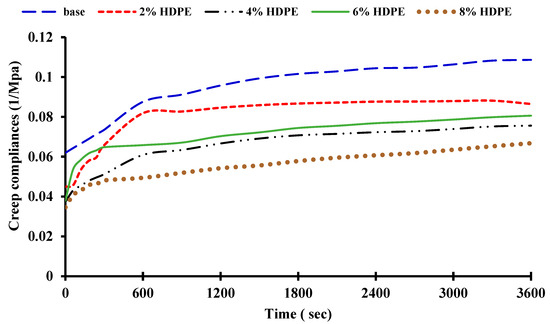
Figure 12.
Creep compliances with time for high-density polyethylene-modified mixtures.
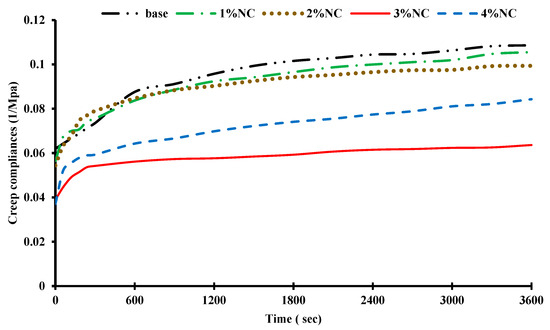
Figure 13.
Creep compliances with time for nano clay-modified mixtures.
In addition, creep compliance criteria were computed utilizing the power low depicted in Equation (5). As shown in Figure 14, the creep compliance factors (a and m) for each asphalt mixture reveal that NC and HDPE modifications have a noticeable effect on creep compliance characteristics. The parameter a indicates the initial deformation provoked during the loading, while the m parameter denotes the increasing trend of creep compliance with time. Therefore, the lower the a and m values, the lower the creep compliance of the asphalt mixture. The results reveal that, except for asphalt mixtures of 2% HDPE and 4% HDPE, the asphalt mixtures of modified binders have a lower m value than the mixture of virgin binder, ensuring the potential of HDPE and NC modifications to undermine the creep compliance of asphalt mixture. Although the mixtures of 2% HDPE and 4% HDPE have relatively high m values, their values are significantly low, indicating low compliance for a creep at the beginning of the load.
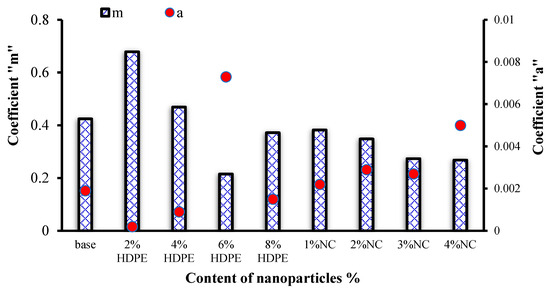
Figure 14.
Creep compliance factors of base and modified mixtures.
The correlation analysis proves a strong correlation between the a and m values of the asphalt mixture. As shown in Figure 15, the higher the value, the lower the m value. In other words, the asphalt mixture of high deformation at the beginning of the loading has a low creep increment with time during the loading stage. This behavior is due to the microstructure characteristics and voids distribution inside the asphalt mixture. The asphalt mixtures of low m value may have a relatively low air void and a homogenous structure, which leads to a gradual increment in the strain by loading instead of a sudden initial high strain. As the modified asphalt mixtures have significantly different a and m values than the mixture of virgin binder, it can be claimed that the different consistency of modified binders affects the microstructure of the asphalt mixture, leading to a different creep behavior. Moreover, as most NC asphalt mixtures have a lower m value than that of virgin binder, it can be said that the binder modification with NC can greatly improve the homogeneity of the asphalt mixture.
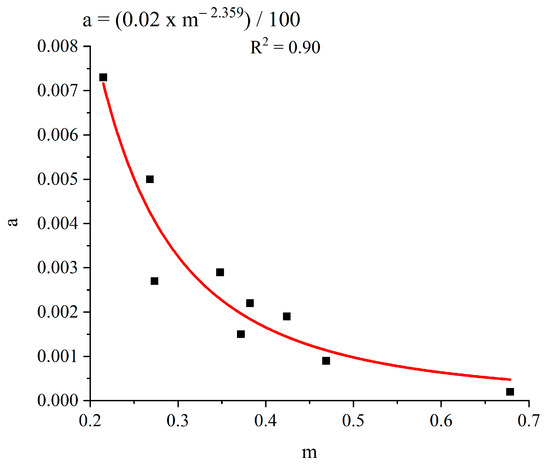
Figure 15.
Correlation between the initial strain and strain propagation with loading time. Note: the correlations are significant according to both statistical tests, t-test and f-test (p value < 0.05).
4.3. Impact of Binder Basic Characteristics on Creep Performance of Asphalt Mixture
The impact of binder consistency and flow on the creep characteristics of asphalt mixture was investigated through the correlation analysis between penetration, softening point, viscosity, and different parameters of creep characteristics. The correlation coefficient (R2) was pursued, while the statistical tests, t-test and f-test, were conducted to check the significance of each predictor and the entire regression model. As shown in Figure 16 and Figure 17, the maximum strain at the end of the loading period and permanent strain at the end of the unloading period are highly correlated to the binder stiffness. Both strains significantly decrease by the reduction of the penetration value and increment of softening point. The high stiffness of the asphalt binder, materialized in low penetration and a high softening point, greatly undermines the strains of the asphalt mixture. Moreover, as shown in Figure 18, the stiffness modulus of the asphalt mixture significantly increases by lowering the binder penetration and escalating the softening point. As the high stiffness of the asphalt mixture implies a low capability for creep and deformation under loading, it can be claimed that the higher the binder stiffness, the higher the asphalt mixture’s potential to resist creep and deformation under axial loading. Generally, the correlation analysis confirms the crucial role of binder stiffness in the creep characteristics of the asphalt mixture.
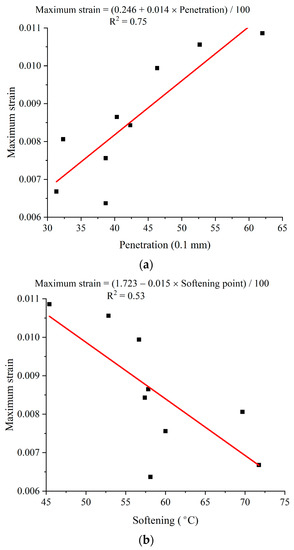
Figure 16.
Impact of binder stiffness on the maximum strain provoked in the asphalt mixture under axial loading. (a) Correlation between maximum strain and penetration value of the asphalt binder; (b) Correlation between maximum strain and softening temperature of the asphalt binder. Note: the correlations are significant according to both statistical tests, t-test and f-test (p value < 0.05).
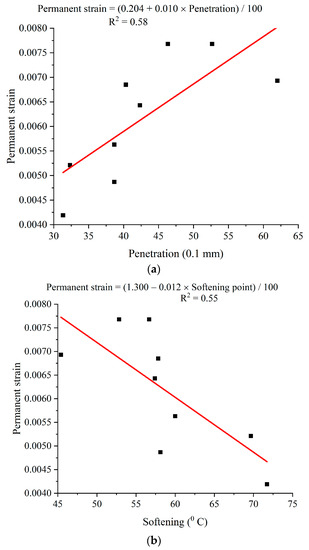
Figure 17.
The impact of binder stiffness on the permanent strain remains in the asphalt mixture after the relaxation period. (a) Correlation between permanent strain and penetration value of the asphalt binder; (b) Correlation between permanent strain and softening temperature of the asphalt binder. Note: the correlations are significant according to both statistical tests, t-test and f-test (p value < 0.05).
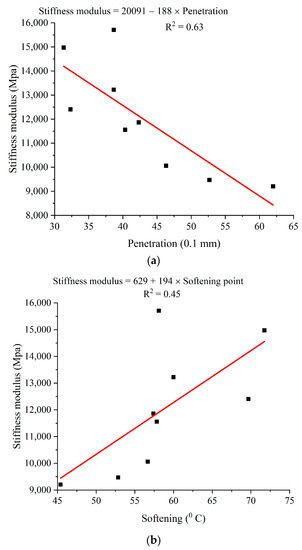
Figure 18.
Impact of binder stiffness on the stiffness modulus of the asphalt mixture. (a) Correlation between stiffness modulus of asphalt mixture and penetration of the asphalt binder; (b) Correlation between stiffness modulus of asphalt mixture and softening temperature of the asphalt binder. Note: the correlations are significant according to both statistical tests, t-test and f-test (p value < 0.05).
On the other hand, the elastic strain materialized in the difference between maximum and permanent strains is highly correlated to the binder viscosity and penetration. Unlike the maximum and permanent strains, the elastic strain significantly increases with the increment of binder penetration. Moreover, the increment of the binder viscosity further improves the elastic response. As previously mentioned in Table 5, the asphalt mixtures of 6% and 8% HDPE have a significantly high elastic strain, while those asphalt binders have a relatively high viscosity, as shown in Figure 19. On the other hand, the other modified binders have a low viscosity than the virgin binder. The HDPE is a thermoplastic polymer, which becomes moldable at elevated temperatures. Therefore, the HDPE modification is expected to enhance the binder elasticity. The NC can be considered a mineral filler, which turns the asphalt binder colloid into a mastic-like colloid structure. The asphalt mastics have higher cohesion strength and stiffer consistency than the asphalt binder. The NC particles do not have an elastic property like asphaltene and resin molecules of asphalt binder. Thus, the increment of the binder stiffness, materialized in the reduction of penetration, due to the NC modification, is expected to be accompanied by a relegation in the elasticity.
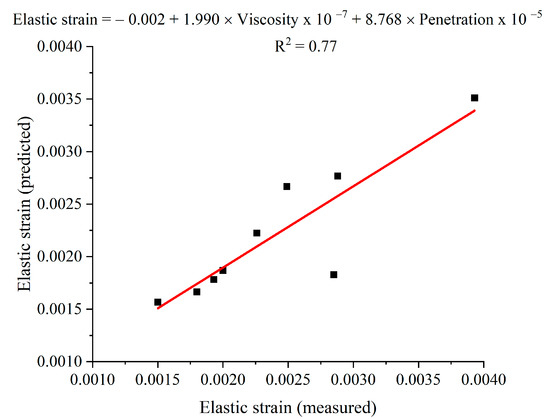
Figure 19.
Impact of binder stiffness on the elastic strain of the asphalt mixture. Note: the correlations are significant according to both statistical tests, t-test and f-test (p value < 0.05).
5. Conclusions
The impact of high-density polyethylene and nano clay on the rutting resistance of the asphalt mixture was examined in this study. Based on the results and correlation analysis, the following conclusions can be encapsulated.
- The HDPE and NC modifications for asphalt binder reduce the penetration value and elevate the softening point of the asphalt binder;
- The asphalt binder modification by HDPE and NC can greatly improve the creep resistance of the asphalt mixture. Under the axial loading, asphalt mixtures of 8% HDPE and 3% NC have permanent strains two times lower than the mixture of the virgin binder;
- The maximum strain at the end of the loading stage and the permanent strain at the end of the unloading stage are highly correlated to the binder basic properties. The higher the penetration value and the lower the softening point of the asphalt binder, the smaller the strains provoked in the asphalt mixture under loading;
- To sum up, future research should focus on establishing correlations between the results of large-scale field investigations. It is crucial to remember that there are several options for low-carbon and sustainable technologies in asphalt pavement.
Author Contributions
Conceptualization, A.A.-R., A.S.M., A.D., G.S.M., Y.O.Ö. and T.A.-W.; methodology, A.A.-R., A.S.M., N.M., R.P.J., G.S.M. and T.A.-W.; software, A.A.-R. and A.S.M.; validation, A.A.-R., A.D., G.S.M., Y.O.Ö., N.M., R.P.J. and T.A.-W.; formal analysis G.S.M., A.S.M. and T.A.-W.; investigation, A.A.-R.; resources, A.D., Y.O.Ö., N.M. and R.P.J.; data curation, A.A.-R., A.S.M., A.D. and G.S.M.; writing—original draft preparation, A.A.-R., A.S.M., A.D., G.S.M., Y.O.Ö., N.M., R.P.J. and T.A.-W.; writing—review and editing, A.A.-R., A.S.M., A.D., G.S.M., Y.O.Ö., N.M., R.P.J. and T.A.-W.; visualization, A.A.-R.; supervision G.S.M. and T.A.-W.; project administration, T.A.-W. and A.D.; funding acquisition, A.D., Y.O.Ö., N.M. and R.P.J. All authors have read and agreed to the published version of the manuscript.
Funding
This research received no external funding.
Institutional Review Board Statement
Not applicable.
Informed Consent Statement
Not applicable.
Data Availability Statement
Not applicable.
Acknowledgments
The support of Assuit University, Sohag University in Egypt and University of Warith Al-Anbiyaa in Iraq is gratefully acknowledged.
Conflicts of Interest
The authors declare no conflict of interest.
References
- Hossain, Z.; Zaman, M.; Hawa, T.; Saha, M.C. Evaluation of Moisture Susceptibility of Nanoclay-Modified Asphalt Binders through the Surface Science Approach. J. Mater. Civ. Eng. 2015, 27, 4014261. [Google Scholar] [CrossRef]
- Abdel-Wahed, T.; Dulaimi, A.; Shanbara, H.K.; Al Nageim, H. The impact of cement kiln dust and cement on cold mix asphalt characteristics at different climate. Sustainability 2022, 14, 4173. [Google Scholar] [CrossRef]
- Singh, A.K.; Sahoo, J.P. Rutting prediction models for flexible pavement structures: A review of historical and recent developments. J. Traffic Transp. Eng. Engl. Ed. 2021, 8, 315–338. [Google Scholar] [CrossRef]
- Mohamed, A.S.; Abdel-Wahed, T.A.; Othman, A.M. Investigating effective maintenance policies for urban networks of residential cities by using optimum and sensitivity analyses. Can. J. Civ. Eng. 2020, 47, 691–703. [Google Scholar] [CrossRef]
- Nicholls, J.C. Asphalt Surfacings; CRC Press: Boca Raton, FL, USA, 1998. [Google Scholar]
- Abdel-Wahed, T.; Rashwan, N.K.; Maurice, A.E. The physical properties of bitumen modified with ilmenite and bentonite nanoparticles. HBRC J. 2020, 16, 335–350. [Google Scholar] [CrossRef]
- Cao, Y.; Liu, Z.; Song, W. Performance and overall evaluation of nano-alumina-modified asphalt mixture. Nanotechnol. Rev. 2022, 11, 2891–2902. [Google Scholar] [CrossRef]
- Polacco, G.; Berlincioni, S.; Biondi, D.; Stastna, J.; Zanzotto, L. Asphalt modification with different polyethylene-based polymers. Eur. Polym. J. 2005, 41, 2831–2844. [Google Scholar] [CrossRef]
- Li, J.; Tang, F. Effects of two metal nanoparticles on performance properties of asphalt binder and stone matrix asphalt mixtures containing waste high density polyethelene. Constr. Build. Mater. 2023, 401, 132787. [Google Scholar] [CrossRef]
- Kalantar, Z.; Mahrez, A.; Karim, M.R. Properties of Bituminous Binder Modified with High Density Penetration Test Results. Int. Eng. Conv. 2009, 11–14. [Google Scholar]
- Putri, E.E.; Vasilsa, O. Improve the Marshall stability of porous asphalt pavement with HDPE addition. In MATEC Web of Conferences; EDP Sciences: Lessulis, France, 2019; p. 3005. [Google Scholar]
- Hinislioglu, S.; Agar, E. Use of waste high density polyethylene as bitumen modifier in asphalt concrete mix. Mater. Lett. 2004, 58, 267–271. [Google Scholar] [CrossRef]
- Kamada, K.; Mukai, M.; Matsumoto, Y. Electrophoretic deposition assisted by soluble anode. Mater. Lett. 2003, 57, 2348–2351. [Google Scholar] [CrossRef]
- Habib, N.Z.; Kamaruddin, I.; Napiah, M.; Isa, M.T. Rheological properties of polyethylene and polypropylene modified bitumen. Int. J. Civ. Environ. Eng. 2011, 3, 96–100. [Google Scholar]
- AL-Harbi, S.M.A.; Ahmed, N.Y.; AL-Harbi, A.S.M. Effect of Density of the Polyethylene Polymer on the Asphalt Mixtures. J. Univ. Babylon 2014, 22, 674–683. [Google Scholar]
- Nejad, F.M.; Gholami, M.; Naderi, K.; Rahi, M. Evaluation of rutting properties of high density polyethylene modified binders. Mater. Struct. 2015, 48, 3295–3305. [Google Scholar] [CrossRef]
- Steyn, W.J. Applications of nanotechnology in road pavement engineering. In Nanotechnology in Civil Engineering; Springer: Berlin/Heidelberg, Germany, 2011; pp. 49–83. [Google Scholar]
- Gou, J.; Wang, G.; Al-Tamimi, H.M.; Alkhalifah, T.; Alturise, F.; Ali, H.E. Application of aluminum oxide nanoparticles in asphalt cement toward non-polluted green environment using linear regression. Chemosphere 2023, 321, 137925. [Google Scholar] [CrossRef]
- Jaffur, N.; Kumar, G.; Jeetah, P.; Ramakrishna, S.; Bhatia, S.K. Current advances and emerging trends in sustainable polyhydroxyalkanoate modification from organic waste streams for material applications. Int. J. Biol. Macromol. 2023, 253, 126781. [Google Scholar] [CrossRef]
- Van de Ven, M.F.C.; Molenaar, A.A.A.; Besamusca, J. Nanoclay for binder modification of asphalt mixtures. In Proceedings of the 7th International RILEM Symposium ATCBM09 on Advanced Testing and Characterization of Bituminous Materials, Rhodes, Greece, 27 May 2009; pp. 133–142. [Google Scholar]
- Sajedi, F.; Razak, H.A. Comparison of different methods for activation of ordinary Portland cement-slag mortars. Constr. Build. Mater. 2011, 25, 30–38. [Google Scholar] [CrossRef]
- Mahdi, L.M.J.; Muniandy, R.; Yunus, R.B.; Hasham, S.; Aburkaba, E. Effect of short term aging on organic montmorillonite nanoclay modified asphalt. Indian J. Sci. Technol. 2013, 6, 5434–5442. [Google Scholar] [CrossRef]
- Mohamed, A.S.; Cao, Z.; Xu, X.; Xiao, F.; Abdel-Wahed, T. Bonding, rheological, and physiochemical characteristics of reclaimed asphalt rejuvenated by crumb rubber modified binder. J. Clean. Prod. 2022, 373, 133896. [Google Scholar] [CrossRef]
- You, Z.; Mills-Beale, J.; Foley, J.M.; Roy, S.; Odegard, G.M.; Dai, Q.; Goh, S.W. Nanoclay-modified asphalt materials: Preparation and characterization. Constr. Build. Mater. 2011, 25, 1072–1078. [Google Scholar] [CrossRef]
- Sadeghnejad, M.; Shafabakhsh, G. Use of Nano SiO2 and Nano TiO2 to improve the mechanical behaviour of stone mastic asphalt mixtures. Constr. Build. Mater. 2017, 157, 965–974. [Google Scholar] [CrossRef]
- ASTM D 5/D 5M; Standard Test Method for Penetration of Bituminous Materials. ASTM International: West Conshohocken, PA, USA, 2013.
- ASTM D2170/D2170M; 18 Standard Test Method for Kinematic Viscosity of Asphalts. ASTM International: West Conshohocken, PA, USA, 2018.
- ASTM D 113-07; Standard Test Method for Ductility of Asphalt Materials. ASTM International: West Conshohocken, PA, USA, 2017.
- ASTM D 92; D92 Test Method for Flash and Fire Points by Cleveland. ASTM International: West Conshohocken, PA, USA, 1989.
- ASTM D 70; Standard Test Method for Specific Gravity and Density of Semi-Solid Bituminous Materials (Pycnometer Method). ASTM International: West Conshohocken, PA, USA, 2017.
- ASTM D 36; ASTM D36-06: Standard Test Method for Softening Point of Bitumen (Ring-and-Ball Apparatus). ASTM International: West Conshohocken, PA, USA, 2006.
- ISO-527-2; Plastics–Determination of Tensile Properties–Part 2: Test Conditions for Moulding and Extrusion Plastics. ISO: Geneva, Switzerland, 1996.
- ISO 178; 2013-09; Plastics-Determination of Flexural Properties (ISO 178: 2010+ Amd. 1: 2013). ISO: Geneva, Switzerland, 2013.
- ASTM D1238-13; Standard Test Method for Melt Flow Rates of Thermoplastics by Extrusion Plastomete. ASTM International: West Conshohocken, PA, USA, 2013.
- ASTM D3418-03 (D 3417-99); Standard Test Method for Transition Temperatures and Enthalpies of Fusion and Crystallization of Polymers by Differential Scanning Calorimetry. ASTM International: West Conshohocken, PA, USA, 2003; pp. 66–72.
- ASTM D 256 ISO 180; Data Retrieved October 12. ASTM International: West Conshohocken, PA, USA, 2004.
- ASTM D 4883; Standard Test Method for Density of Polyethylene by the Ultrasound Technique 1, East. ASTM International: West Conshohocken, PA, USA, 1999; pp. 5–7.
- Zafari, F.; Rahi, M.; Moshtagh, N.; Nazockdast, H. The Improvement of Bitumen Properties by Adding NanoSilica. Study Civ. Eng. Archit. 2014, 3, 62–69. [Google Scholar]
- Moussa, G.S.; Abdel-Raheem, A.; Abdel-Wahed, T. Effect of Nanoclay Particles on the Performance of High-Density Polyethylene-Modified Asphalt Concrete Mixture. Polymer 2021, 13, 434. [Google Scholar] [CrossRef] [PubMed]
- Egyptian Code of Practice for Urban and Rural Roads Part 4: Road Material and Its Tests; Housing and Building National Research Center: Giza, Egypt, 2018.
- ASTM D5581; Test Method for Resistance of Plastic Flow of Bituminous Mixtures Using Marshall Apparatus. Annual B ASTM Standard. American Society for Testing and Materials: Philadelphia, PA, USA, 1998.
- AASHTO T209; Standard Method of Test for Theoretical Maximum Specific Gravity (Gmm) and Density of Asphalt Mixtures. AASHTO: Washington, DC, USA, 2020.
- ASTM C131-06; Standard Test Method for Resistance to Degradation of Small-Size Coarse Aggregate by Abrasion and Impact in the Los Angeles Machine. ASTM International: West Conshohocken, PA, USA, 2006.
- ASTM D5821; Standard Test Method for Determining the Percentage of Fractured Particles in Coarse Aggregate. ASTM International: West Conshohocken, PA, USA, 2017.
- ASTM D4791-10; Standard Test Method for Flat Particles, Elongated Particles, or Flat and Elongated Particles in Coarse Aggregate. ASTM International: West Conshohocken, PA, USA, 2010.
- ASTM C127-12; Standard Test Method for Density, Relative Density (Specific Gravity), and Absorption of Coarse Aggregate. ASTM International: West Conshohocken, PA, USA, 2012.
- Bitumen, S. The Shell Bitumen Handbook; Shell Bitumen: Cheshire, UK, 1990. [Google Scholar]
- Kumar, P.; Mehndiratta, H.C.; Singh, K.L. Comparative study of rheological behavior of modified binders for high-temperature areas. J. Mater. Civ. Eng. 2010, 22, 978–984. [Google Scholar] [CrossRef]
- Saboo, N.; Kumar, P. Optimum blending requirements for EVA modified binder. Transp. Res. Procedia 2016, 17, 98–106. [Google Scholar] [CrossRef]
- Tam, W.O.; Solaimanian, M.; Kennedy, T.W.; River, R. Development and Use of Static Creep Test to Evaluate Rut Resistance of Superpave Mixes (FHWA-TX-1250-4), Work; The University of Texas at Austin: Austin, TX, USA, 2000; Volume 7, p. 4. [Google Scholar]
- Yuan, Q.; Shi, C.; De Schutter, G.; Audenaert, K.; Deng, D. Chloride binding of cement-based materials subjected to external chloride environment—A review. Constr. Build. Mater. 2009, 23, 1–13. [Google Scholar] [CrossRef]
- Chen, S.; Xu, L.; Jia, S.; Wang, J. Characterization of the nonlinear viscoelastic constitutive model of asphalt mixture. Case Stud. Constr. Mater. 2023, 18, e01902. [Google Scholar] [CrossRef]
- Hamzah, M.O.; Jaya, R.P.; Prasetijo, J.; Azizi, K. Effects of temperature and binder type on the dynamic creep of asphaltic concrete incorporating geometrically cubical aggregates subjected to ageing. Mod. Appl. Sci. 2009, 3, 3–14. [Google Scholar] [CrossRef]
- Mohamed, A.S.; Xiao, F.; Hettiarachchi, C.; Abdel-Wahed, T. Bond strength in dry condition of reclaimed asphalt modified by crumb rubber modified binder. J. Adhes. 2023, 99, 691–720. [Google Scholar] [CrossRef]
- Al-Omari, A.A.; Khasawneh, M.A.; Al-Rousan, T.M.; Al-Theeb, S.F. Static creep of modified superpave asphalt concrete mixtures using crumb tire rubber, microcrystalline synthetic wax, and nano-silica. Int. J. Pavement Eng. 2021, 22, 794–805. [Google Scholar] [CrossRef]
- Liu, H.; Wang, J.; Lu, W.; Zhang, N. Optimization Design and Mechanical Performances of Plant-Mix Hot Recycled Asphalt Using Response Surface Methodology. Materials 2023, 16, 5863. [Google Scholar] [CrossRef] [PubMed]
- Onyango, M.A. Verification of Mechanistic Prediction Models for Permanent Deformation in Asphalt Mixes Using Accelerated Pavement Testing. Ph.D. Thesis, Kansas State University, Manhattan, KS, USA, 2009. [Google Scholar]
- Mohamed, A.S.; Abdel-Wahed, T.A.; Othman, A.M. Investigating the effect of corrective maintenance on the pavement life cycle and the optimal maintenance strategies. In CICTP 2019; American Society of Civil Engineers: Reston, VA, USA, 2019; pp. 811–822. [Google Scholar]
Disclaimer/Publisher’s Note: The statements, opinions and data contained in all publications are solely those of the individual author(s) and contributor(s) and not of MDPI and/or the editor(s). MDPI and/or the editor(s) disclaim responsibility for any injury to people or property resulting from any ideas, methods, instructions or products referred to in the content. |
© 2023 by the authors. Licensee MDPI, Basel, Switzerland. This article is an open access article distributed under the terms and conditions of the Creative Commons Attribution (CC BY) license (https://creativecommons.org/licenses/by/4.0/).